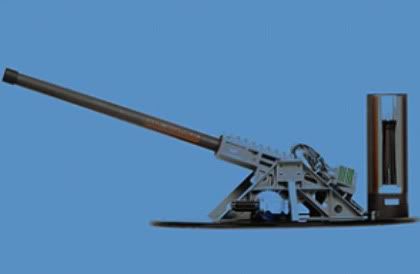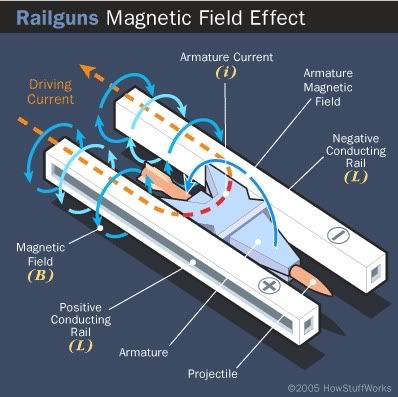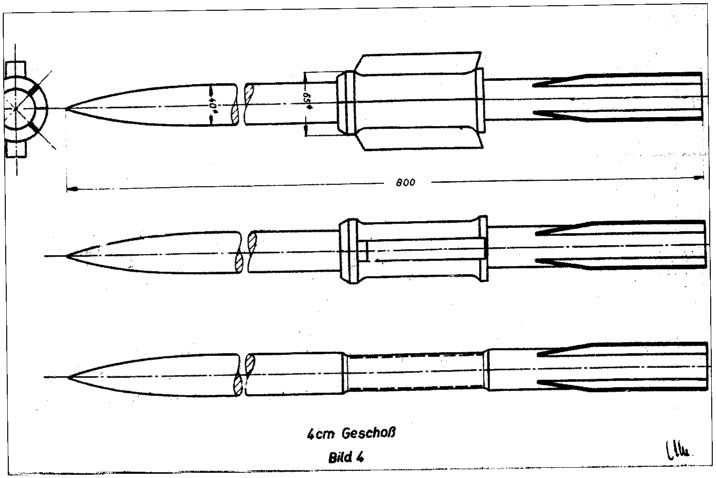Mechanics
A railgun is an entirely electrical gun that accelerates a conductive projectile along a pair of metal rails using the same principles as the homopolar motor. Railguns use two sliding or rolling contacts that permit a large electric current to pass through the projectile. This current interacts with the strong magnetic fields generated by the rails and this accelerates the projectile.
The U.S. Navy has tested a railgun that accelerates a 3.2 kg projectile to seven times the speed of sound.
Railguns should not be confused with:
Coilguns (Gauss guns), which are contactless and use a magnetic field generated by external coils arranged along the barrel to accelerate a magnetic projectile.
Railway guns, which are very large artillery pieces placed on railway tracks and predominantly used in and between the American civil war and the Second World War.
Railguns, a type of sporting rifle generally used in Benchrest shooting.
A railgun consists of two parallel metal rails (hence the name) connected to an electrical power supply. When a conductive projectile is inserted between the rails (at the end connected to the power supply), it completes the circuit. Electrons flow from the negative terminal of the power supply up the negative rail, across the projectile, and down the positive rail, back to the power supply.
This current makes the railgun behave as an electromagnet, creating a powerful magnetic field in the region of the rails up to the position of the projectile. In accordance with the right-hand rule, the magnetic field circulates around each conductor. Since the current is in opposite direction along each rail, the net magnetic field between the rails (B) is directed vertically. In combination with the current (I) across the projectile, this produces a Lorentz force which accelerates the projectile along the rails. There are also forces acting on the rails attempting to push them apart, but since the rails are mounted firmly, they cannot move. The projectile slides up the rails away from the power supply.
A very large power supply providing, on the order of, one million amperes of current will create a tremendous force on the projectile, accelerating it to a speed of many kilometres per second (km/s). 20 km/s has been achieved with small projectiles explosively injected into the railgun. Although these speeds are possible theoretically, the heat generated from the propulsion of the object is enough to erode the rails rapidly. Such a railgun would require frequent replacement of the rails, or to use a heat resistant material that would be conductive enough to produce the same effect.
The rails and projectiles must be built from strong conductive materials; the rails need to survive the violence of an accelerating projectile, and heating due to the large currents and friction involved. The recoil force exerted on the rails is equal and opposite to the force propelling the projectile. The seat of the recoil force is still debated. The traditional equations predict that the recoil force acts on the breech of the railgun. Another school of thought invokes Ampère's force law and asserts that it acts along the length of the rails (which is their strongest axis). The rails also repel themselves via a sideways force caused by the rails being pushed by the magnetic field, just as the projectile is. The rails need to survive this without bending, and must be very securely mounted.
The power supply must be able to deliver large currents, sustained and controlled over a useful amount of time. The most important gauge of power supply effectiveness is the energy it can deliver. As of February 2008, the greatest known energy used to propel a projectile from a railgun was 32 million joules. The most common forms of power supplies used in railguns are capacitors and compulsators which are slowly charged from other continuous energy sources.
The rails need to withstand enormous repulsive forces during shooting, and these forces will tend to push them apart and away from the projectile. As rail/projectile clearances increase, arcing develops, which causes rapid vaporization and extensive damage to the rail surfaces and the insulator surfaces. This limited some early research railguns to one shot per service interval.
The inductance and resistance of the rails and power supply limit the efficiency of a railgun design. Currently different rail shapes and railgun configurations are being tested, most notably by the United States Navy, The Institute for Advanced Technology, and BAE Systems.
Massive amounts of heat are created by the electricity flowing through the rails, as well as by the friction of the projectile leaving the device. The heat created by this friction itself can cause thermal expansion of the rails and projectile, further increasing the frictional heat. This causes three main problems: melting of equipment, decreased safety of personnel, and detection by enemy forces. As briefly discussed above, the stresses involved in firing this sort of device require an extremely heat-resistant material. Otherwise the rails, barrel, and all equipment attached would melt or be irreparably damaged.
In practice the rails are, with most designs of railgun, subject to erosion due to each launch; and projectiles can be subject to some degree of ablation also, and this can limit railgun life, in some cases severely.
Projectile The projectile is essentially an 8 kilogram depleted uranium and tungsten round nose dart with fins attached for extra guidance and the reduction of air resistance making the round less accurate. Ordinarily, a round like this would possess dimples, much how a basketball, golfball, or football would, however the projectile moves throughout the air so rapidly that it produces a large stream of plasma behind it, and by increasing the drag ratio to a higher amount, when the round finally impacts and stops behind it's target the massive amount of plasma trailing the round will serve as another form of catastrophic damage, the immense heat from the air literally vaporizing the materials around it, increasing the lethality and damage of the heavily powered projectile. Although the round has a 110 mile range, it's most effective range is roughly 50 miles, as this allows for a nearly completely linear trajectory, allowing the round to retain most of it's horizontal velocity without first experiencing a fall due to gravity.








